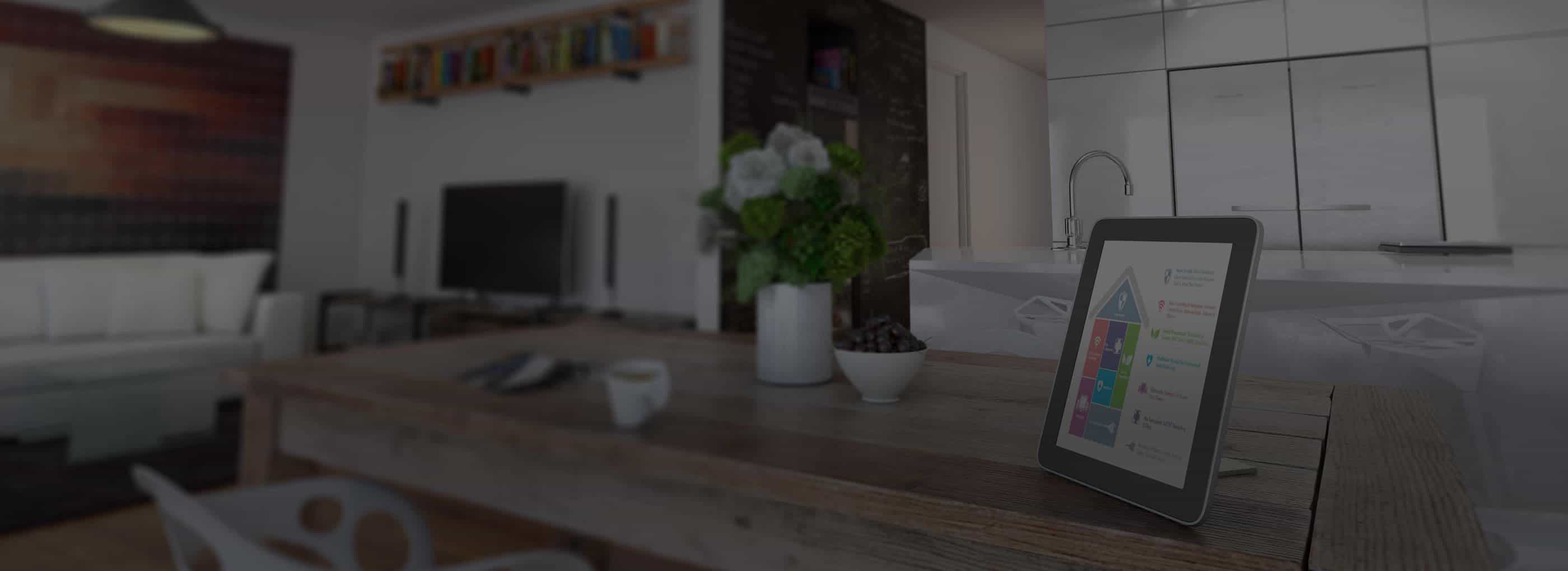When people think about a smart home, they usually picture something reminiscent of the Jetsons. Voice-activated, mechanized breakfast assembly bars. Exercise equipment that puts itself away at the wave of a hand. Video monitors that descend from the ceiling when your wife calls on her way home from her job managing the sprocket factory.
We’re not quite there yet, but there have been incredible leaps forward in the home-automation industry. A large part of these innovations stem from the Internet of Things (IoT) technology. The smart-home industry has also been propelled by remarkable advancements in machine learning and artificial intelligence technologies. However, before we dive into those exciting developments, let’s understand the concept of home automation itself.
What Exactly Is Home Automation?
Home automation is exactly what it sounds like. It’s the addition of smart devices to a home, apartment, condo, or wherever else someone lives that takes a manual task and makes it automatic. It could be as simple as adjusting the thermostat if the humidity gets too high or as complicated as a “bedtime” voice command that lowers the lights, turns off the living room TV, switches on the outdoor motion-activated floodlights, and turns on the bedroom fan.
Did You Know? Experts disagree on the exact origins of the “smart” home, but many argue it can be traced back to the 1975 release of X10. That was a home-automation platform that sent 120 kHz signals through a home’s existing electrical wiring so users could remotely control devices using a command console.1
These actions all have something to do with remote control, scheduling, or self-learning. Let’s take a look at some examples to better understand the concepts:
- Remote control: Turning off your TV with your smartphone.
- Scheduling: Setting your security cameras to switch on at night.
- Self-learning: Your home learns to cool the house to 72 when you’re home, but let the temperature rise to 78 when you’re not there.
Individual systems operating using one of these three mechanisms is pretty cool, but things get really interesting when the systems start communicating with each other and working together. To do that, they all need to be working on the same network or protocol. That brings us to the next important concept: the Internet of Things.
Understanding the Internet of Things
If you have a traditional understanding of the internet, you may think it’s the place you go to check your email using your computer. You’re not wrong, but that’s a limited conception of the internet. All sorts of devices are now internet-connected, and with the right configuration, can share data with other devices that can all learn from each other. Hence the Internet of Things.
Did You Know? In 2024, there were more than 17.5 billion — that’s with a b — active IoT devices globally, and this number is expected to double by 2030.2
The things in your home with sensors, processing ability, and software can connect over the internet or some other communications network — like Z-Wave or Bluetooth — to automate processes. With the right technology, these home networks can even learn about your habits and predict what you want. That’s where artificial intelligence and machine learning come into play.
What Are AI and Machine Learning, and What’s the Difference?
You may have heard of the terms before, but you may not have a firm grasp of what they are or how they work outside of science fiction. Let’s start by defining them.
- Artificial intelligence: Simply put, this is the ability of computers to think like a human and perform tasks on their own.
- Machine learning: This is the process by which a computer establishes, develops, and refines its intelligence.
Notice the key distinction here. Artificial intelligence allows your video doorbell to recognize a package, but its ability to refine what is a package and what isn’t is based on machine learning. Both are important and interconnected concepts when we’re talking about smart homes, so let’s define that now.
What Qualifies as a Smart Home?
Simply put, a smart home is one that benefits from some form of home automation. There is no real threshold for what exactly qualifies as a smart home though. If you have a thermostat that adjusts itself, that could be considered a smart home. If you have every item in your house networked to the point where your lights turn on when your alarm clock goes off, your toaster oven starts cooking your bacon, and your digital assistant greets you with “good morning, captain,” congratulations. Also that’s pretty smart.
Did You Know? The global smart-home market was valued at $127.8 billion in 2024 with a compound annual growth rate of 27 percent from 2025 to 2030. That means it’s expected to reach over $500 billion by the end of the decade.3
The long and short of it is this: A smart home is one where you leverage technology to make your life a little easier. Whether it’s your dryer sending an alert to your phone that your laundry is done or your security camera recognizing a stranger is approaching and telling your doors to automatically lock, a smart home works for its owner instead of the other way around.
That brings us to our next point: There are many benefits to smartening things up at home.
What Are the Benefits of Home Automation?
There are tons of reasons you may want to invest in home automation, but they generally fall into five key categories.
- Convenience. This is one of the primary reasons people start down the smart-home path. It just makes life a little easier when your home automates all the mundane tasks you used to have to do on a day-to-day basis. If your robot vacuum knows to clean the kitchen every Saturday, it means you don’t have to.
- Safety. A lot of smart-home technology is centered around your home’s security system, and there’s a good reason for that. No one piece of security equipment will protect your home comprehensively, but a network of pieces of equipment all working and thinking together can.
- Sustainability. It may seem inconsequential, but a lot of energy is wasted when you leave the lights on or keep your AC running when you’re gone for the weekend. Smart homes can adjust themselves to your habits, reducing your environmental impact.
- Savings. You waste a lot of money when you leave things running unnecessarily. Your smart home will improve your economic efficiency by helping you remember to turn things off or down when they’re not needed.
- The “wow” factor. Let’s be honest: Home automation is cool. How neat is it that your home recognizes you and automatically adjusts itself to your preferences when you walk in the door? That’s some Star Trek stuff right there.
Let’s assume you’re convinced to start building out your smart home. How do you begin? With all the equipment, things can be a little daunting.
Where Do I Start?
Start by considering what matters most to you. Are you looking for an advanced security system? Are you trying to minimize your environmental impact while saving money? Are you just interested in the “wow” factor of having a house that responds to voice commands? Is it a combination of everything? The answers to these questions will help you determine how to tackle your smart-home project.
Once you figure out your needs, remember to start small. The good thing about smart-home technology is that it’s synergistic, meaning each item you add will build to a sum that’s greater than its parts. If you purchase a video doorbell today, later you can buy security cameras that communicate with it. Then you can get a hub that will announce the name of the person coming to your door, and a smart lock that will open when the familiar face is recognized. And that’s not just a hypothetical example. Read our review of Google Nest Cameras to see it in action.
Going from “Little House on the Prairie” to “2001: A Space Odyssey” isn’t easy. There are two paths you can take, and that decision will depend on your budget and how handy you are.
DIY or Professionally Installed?
Back in the day, security systems and other home tech had to be professionally installed. That’s no longer the case. If you’re comfortable with a level and power drill, you can have a pretty solid smart system set up this weekend. There are plenty of companies that cater to this approach. Read our review of Frontpoint for an example.
Pro Tip: Never try to do work outside your comfort or skill level. Improperly installed electronics can be a hazard to your safety, as well as the safety of your property.
If you can’t tell the difference between a screwdriver and a soldering iron, you may want to go the professional installation route. There are a few benefits to this approach that we detail in our review of Vivint, but they include not having to get your hands dirty and getting the advice of someone who really knows what they’re talking about when it comes to home automation.
When considering which type of home-automation system you want, there are some things to keep in mind. We’ve gone over some already, but let’s talk about one of the biggest.
Are There Any Dangers of Having a Smart Home?
Your smart home will likely incorporate your physical security system, but there’s a threat that lots of people don’t consider when automating their home: digital attacks. Each piece of equipment in your smart home is internet-connected, which means it could be a vector for cyber attack. If a hacker makes their way onto your network, your private data could become vulnerable.
Pro Tip: If a hacker penetrates your home network, you’re definitely at risk for identity theft. If you want to prevent this nightmare from happening to you, consider investing in an identity theft protection service.
If you’re interested in building out a home-automation network, it’s best to invest in a VPN that has router-level protection. That will make your data nearly invisible to cyber criminals and protect your data while you’re protecting your property.
How Much Does Home Automation Cost?
It’s a great question, but it doesn’t have a definite answer. You could spend a couple hundred bucks on some affordable security cameras, or you could spend tens of thousands of dollars outfitting your home with every technological bell and whistle available. The question, really, is how much do you want to spend?
We understand that’s an unsatisfying answer. Recent industry research finds that the average home-automation system costs between $200 and $1,600.4 However, comprehensive whole-home automation systems can range from $2,000 to $10,000 or more. Like we said, though, that figure can fluctuate pretty wildly depending on your wants and needs.
So that begs the question: Is it even worth pursuing in the first place?
Is Home Automation Worth It?
This is a question only you can answer. How much do you value your security? How much do you value your time? How much do you want to save on your energy bills? How much do you want to impress your friends and family when they come over? The question of value is subjective and personal.
When you consider the benefits and costs, however, the former often outweighs the latter in our experience. Smart home devices reduce our energy consumption by about 30 percent on a monthly basis. That’s why there’s really no time like the present to get started. Check out our guide to the best home-automation security systems for more information.

